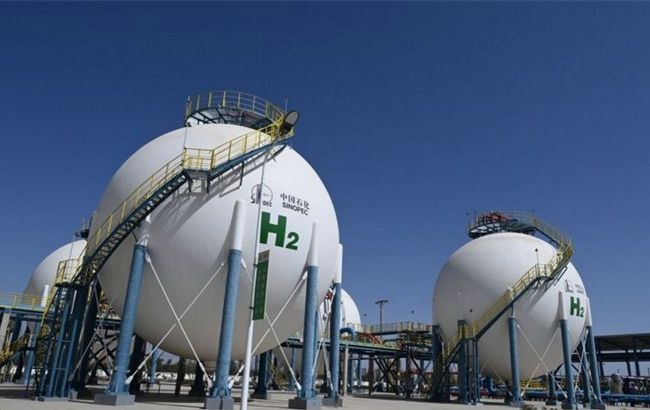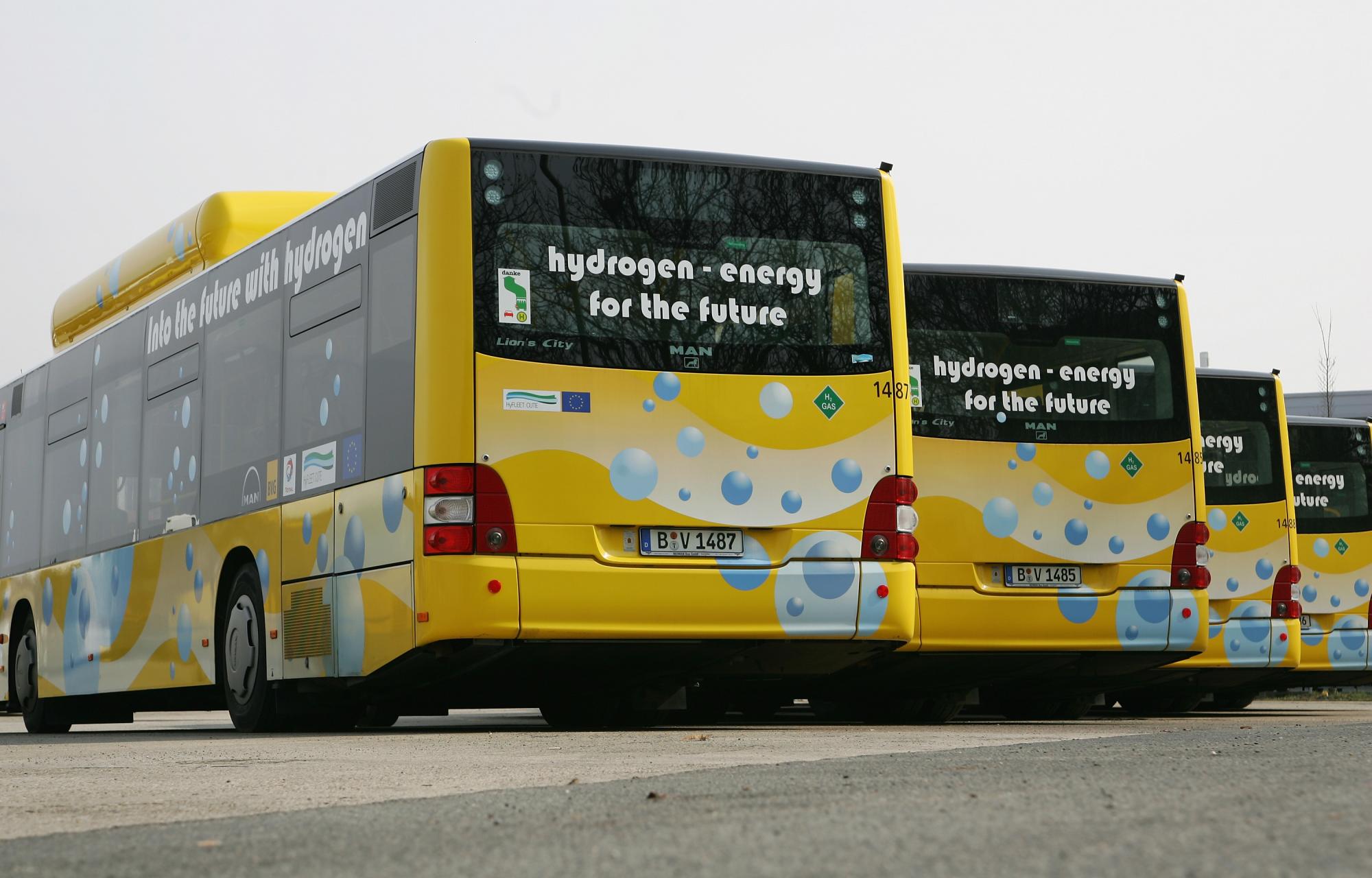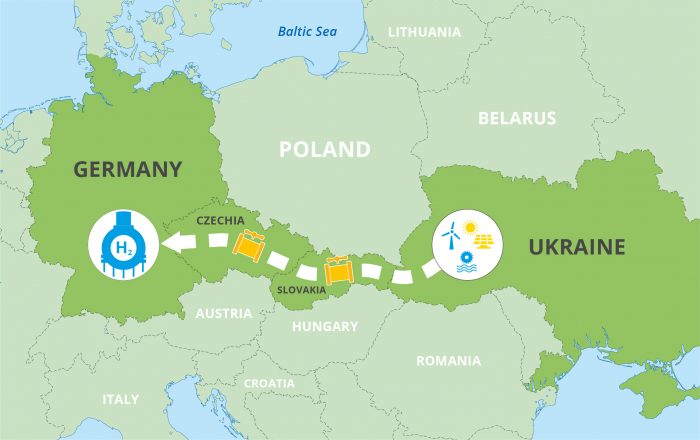Water energy: What green hydrogen is and how Ukraine plans to produce it
 Photo: The largest green hydrogen project to date has been launched in China (chinanews.com)
Photo: The largest green hydrogen project to date has been launched in China (chinanews.com)
Against the backdrop of the European energy transition, Ukraine sees itself as one of the largest exporters of green hydrogen. However, serious investments are needed to realize this vision.
Read more about hydrogen energy, what green hydrogen is, why it is needed, and Ukraine's potential in this area in RBC-Ukraine's article.
Contents
- Gray, blue, green: What is hydrogen and why is it needed
- Global trends and why EU relies on green hydrogen from Ukraine
- Ukraine's potential and where will hydrogen valleys appear
Gray, blue, green: What is hydrogen and why is it needed
Hydrogen is the most abundant chemical element in nature. It accounts for 75% of the mass of the Universe, and on Earth, hydrogen is found in water, natural gas, coal, and oil.
Hydrogen is called a clean alternative to methane, which is the basis of gas. It is seen as a long-term solution in the strategy of reducing emissions in the most carbon-intensive sectors, including electricity generation, transportation, etc.
The main characteristic that makes hydrogen (H2) an attractive alternative to fossil fuels is its ability to burn without emitting CO2. Theoretically, it can replace all fuels, and existing technologies allow for the production of hydrogen using only water and electricity.
Another important characteristic is that energy in the form of hydrogen can be stored longer than in batteries. And if necessary, it can be converted into electricity again or burned instead of fossil fuels.
 Photo: hydrogen could become the fuel of the future (Getty Images)
Photo: hydrogen could become the fuel of the future (Getty Images)
To produce hydrogen, it must be separated from other elements. The main methods are steam reforming of methane and electrolysis (splitting water using electricity). Depending on the method of production, the final product is distinguished by its color.
Steam reforming, the most popular type of production, is the conversion (combination) of methane with water vapor. The output is hydrogen and carbon dioxide as a by-product. If CO2 is released into the atmosphere during the process, hydrogen is called “gray”. If it is captured, it is called “blue”.
According to the International Renewable Energy Agency (IRENA), about 98% of hydrogen is produced from fossil fuels. The remaining 2% is produced using renewable energy sources (wind, solar, and water) to split water molecules into hydrogen and oxygen during electrolysis. This process does not emit any greenhouse gases, which is why such hydrogen is called “green”.
Hydrogen is already used as a fuel for cars. China leads the way in terms of the number of hydrogen filling stations, followed by Japan, South Korea, Germany, and the United States. The international postal operator DHL, for example, has a fleet of vans that can travel 500 km on hydrogen without refueling. It is also considered the fuel of the future for ships and aircraft.
Oil refining, ammonia, methanol, and steel production are the main industries that require significant volumes of H2. And since only gray hydrogen is produced on an industrial scale, the International Energy Agency (IEA) emphasizes the importance of switching to green hydrogen.
When mixed with natural gas, hydrogen can be used for heating. The greatest potential is in apartment and commercial buildings, especially in densely populated cities. Longer-term prospects may include the use of hydrogen boilers or fuel cells.
It also plays an important role in electricity generation. In particular, hydrogen is one of the leading options for storing renewable energy, and hydrogen and ammonia can be used in gas turbines. Or in power plants, where hydrogen fuel cells generate electricity by combining hydrogen and oxygen atoms.
Global trends and why the EU relies on green hydrogen from Ukraine
Right now, green hydrogen is hardly produced in the world. But current trends suggest that there will be more of it every year.
According to the hydrogen project database, China is the largest producer and consumer. Most of the hydrogen produced is based on fossil fuels, but the country has big plans to scale up green hydrogen to decarbonize steel and chemical production.
Next on the list is Saudi Arabia, which is building the largest green hydrogen project. A joint venture between ACWA Power, Air Products, and Neom plans to launch up to 4 GW of solar and wind generation to produce up to 600 tons of hydrogen per day. This means production of more than 200 kilotons per year, while the largest Chinese facility has a capacity of just over 44 kilotons.
Next comes Sweden, which is preparing to launch a large electrolysis plant. Other EU members such as Germany and France are also in the top 10. It should be noted that the EU has outlined plans to produce and import a total of 20 million tons of green hydrogen by 2030. It has also set ambitious goals to increase the use of hydrogen in industry and transportation.
According to the IEA, the world produces a total of 180 kiloliters of hydrogen per year through electrolysis. But by 2030, the volume could exceed 14,000 kilograms if all the projects that are already under construction are put into operation.
This week, the German company EnBW announced the allocation of 1 billion euros for the construction of pipelines for the transportation of pure hydrogen as part of a plan to create a nationwide network by 2032.
Germany has become the locomotive of the European Union's green energy transition. Which turned out to be urgent after the reduction of cheap Russian gas supplies due to Russia's invasion of Ukraine.
Read more about this in the article “Green energy: Pros, cons, and why Ukraine needs energy transition”.
Germany's central location makes it suitable for the role of a European hydrogen hub. But the German network is only one element of an ambitious strategy to transport 20 million tons of hydrogen by 2030.

Photo: Scheme of the hydrogen corridor from Ukraine to Germany (tsoua.com)
Six corridors consisting of pipelines, port terminals, shipping routes, production and storage facilities will be directly or indirectly connected to Germany. The corridors will connect supply and demand in different parts of Europe. And one of them, the Central European Hydrogen Corridor, will pump hydrogen from Ukraine.
Germany directly considers our country as a partner. In March, the chairman of the German Hydrogen Council, Katerina Reiche, confirmed her interest in supplies from Ukraine.
She said that Germany was convinced the creation of a hydrogen economy could make an important contribution to the restoration of Ukraine's energy system and offer significant potential for Europe.
In August 2021, the National Security and Defense Council instructed the government to consider the possibility of creating a hydrogen pipeline in the EU and assess investment attraction. A month later, gas transmission operators from Ukraine, Germany, Czechia, and Slovakia presented the project of the Central European Hydrogen Corridor, and in November 2023, it was supported by the European Commission.
Ukraine's potential and where will hydrogen valleys appear
Ukraine is one of the EU's priority partners in the future hydrogen economy. In 2021, the Ministry of Energy, Energoatom, and the GTS Operator joined the European Clean Hydrogen Alliance.
The competitive advantages and opportunities of our country will be reflected in the hydrogen strategy until 2050. The draft was made public in May and is expected to be adopted in the summer.
According to the project, hydrogen production should reach 1.3 million tons by 2035 and 3 million tons by 2050. According to preliminary estimates, investments in the realization of the 10 GW electrolysis potential could amount to up to $13.5 billion.
The strategy envisages the creation of so-called hydrogen valleys in Zakarpattia, near Reni (Odesa region), as well as Novoyavorivsk and Dashava (Lviv region). One of the potential projects could be located in the Chornobyl exclusion zone.
According to the calculations of the Institute of Renewable Energy of the National Academy of Sciences of Ukraine, the total potential for average annual production of renewable hydrogen is 44.96 million tons.
Currently, hydrogen production is about 360,000 tons per year, which is mainly used to produce ammonia. Although this is only 0.5% of total global demand, with investment, Ukraine can significantly increase its capacity.
Among the ambitious undertakings is the H2U Hydrogen Valley project. It is part of the international Mission Innovation initiative and is being implemented by Hydrogen of Ukraine. Within its framework, two hydrogen valleys are being created in Odesa and Zakarpattia regions.
In the first stage, they want to build a 100 MW electrolysis plant (with the prospect of increasing to 200 MW) in the port city of Reni. Energy for electrolysis will come from wind and solar power plants, and water from the Danube and its tributaries. The construction of 120 MW and 80 MW solar and wind power plants is planned, and the construction of a hydrogen pipeline is being studied.
The second valley is located in the Transcarpathian region bordering Slovakia. An 1100 MW electrolysis plant with the possibility of expanding to 1500 MW will be built there on an area of 120 hectares. The project includes the installation of a large solar power plant and wind turbines. The hydrogen will be supplied to a steel plant in Kosice.
The pilot project in Reni was launched in April-May 2024. Currently, the main task is to form a feasibility study for the components of the hydrogen valleys.
As for the electrolysis plant, three models will be considered. The first is the production of pure hydrogen, the second is renewable ammonia, and the third is green methanol, says Yaroslav Kryl, the company's director. He explains why this technology is safe for the environment.
To produce hydrogen, you need water and a large amount of electricity. For this purpose, electrolyzers are used, which will receive electricity from solar power plants and wind farms. At the electrodes, water is split into hydrogen and oxygen molecules, an environmentally friendly method that produces no waste.
“When we take hydrogen and, for example, supply it to fuel cells or refuel hydrogen-powered cars, the cell undergoes a reverse process: hydrogen reacts with oxygen to generate electricity and water. In other words, we have split water into hydrogen and oxygen using energy, and then there is a recovery cycle to produce water and electricity. And these are not fossil fuels that run out because the sun shines and the wind blows every day. This way, we do not pollute the atmosphere and do not disrupt the natural cycle by returning water to circulation,” emphasizes Kryl.
In his opinion, in two years, Ukrainian hydrogen valleys will be able to add to the list of European projects for the production of green hydrogen.
Sources: International Energy Agency (IEA), Reuters, UK energy company National Grid, the Ministry of Energy of Ukraine, and an interview with Yaroslav Kryl, Director of Hydrogen of Ukraine company, for the Ukrainian Energy portal.

